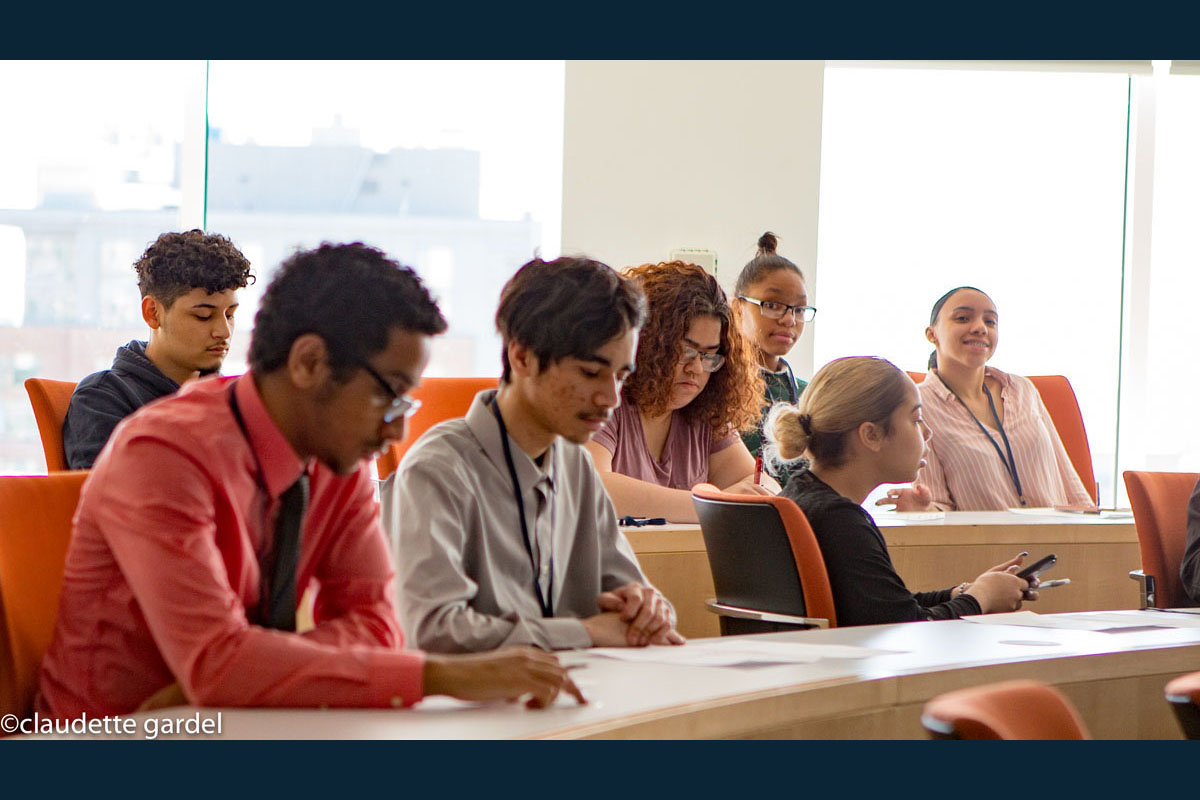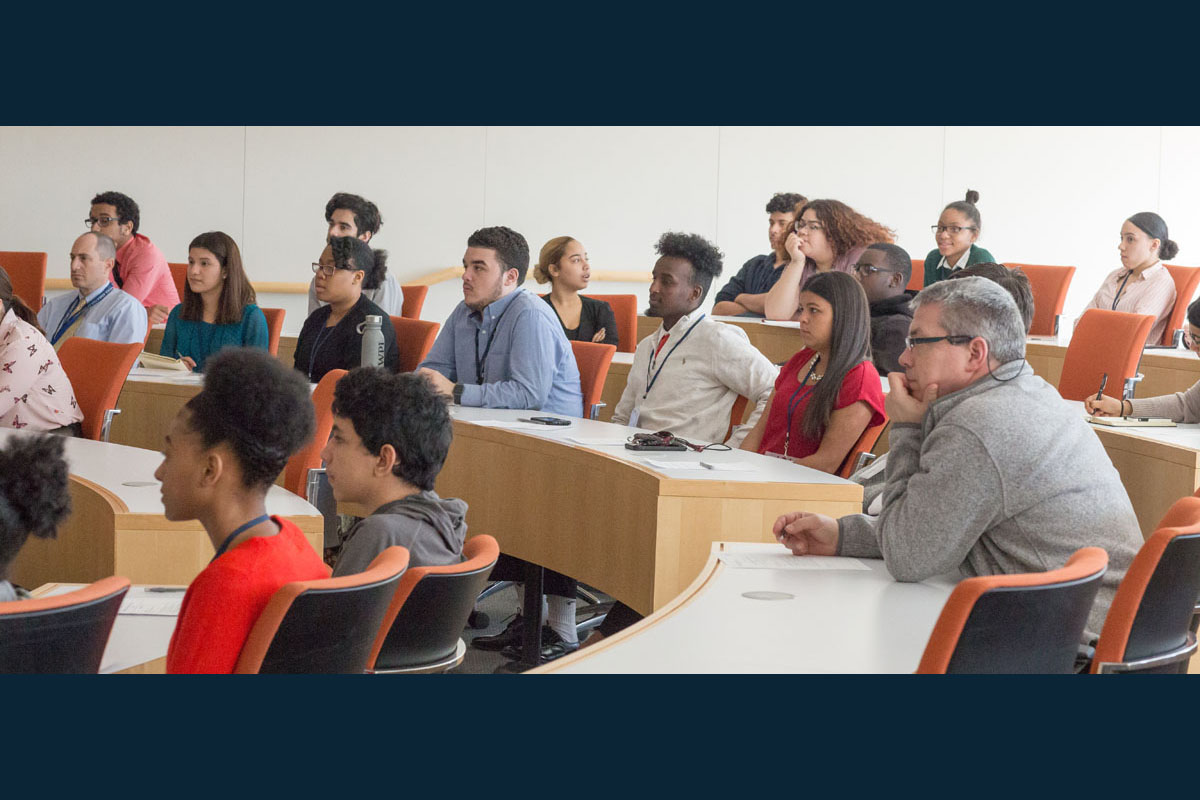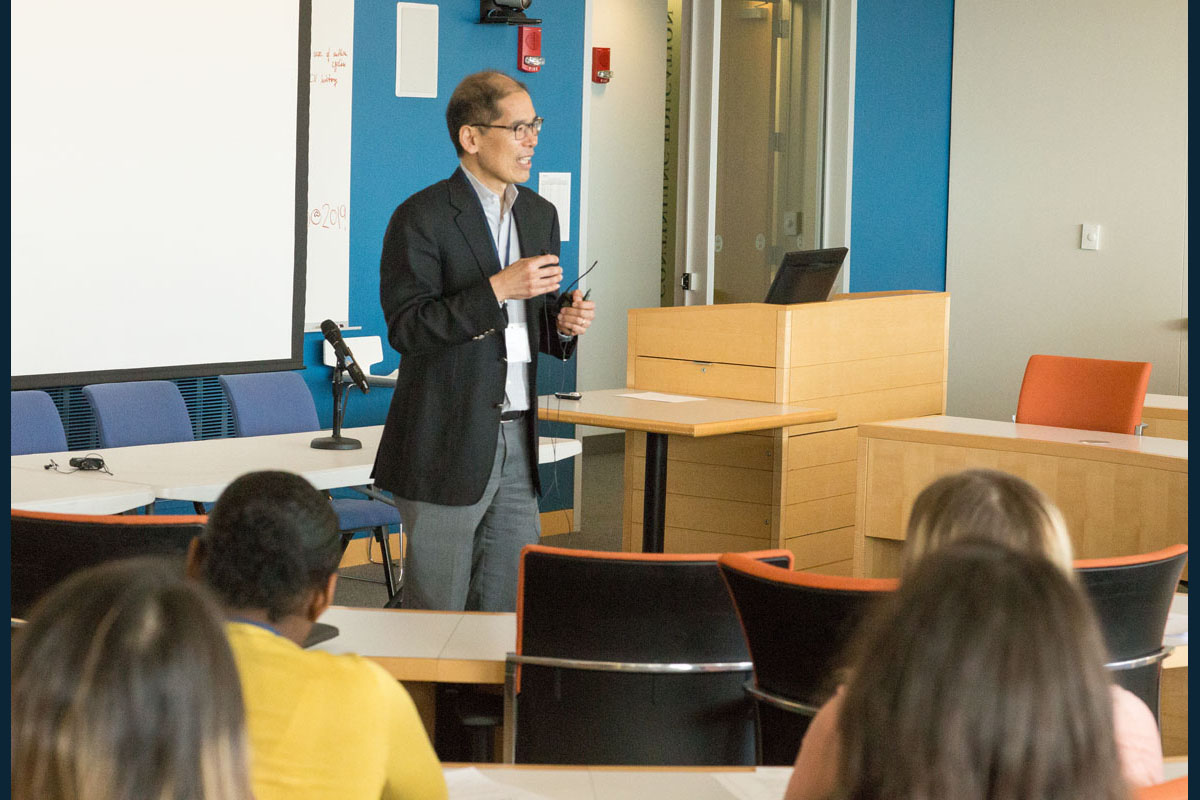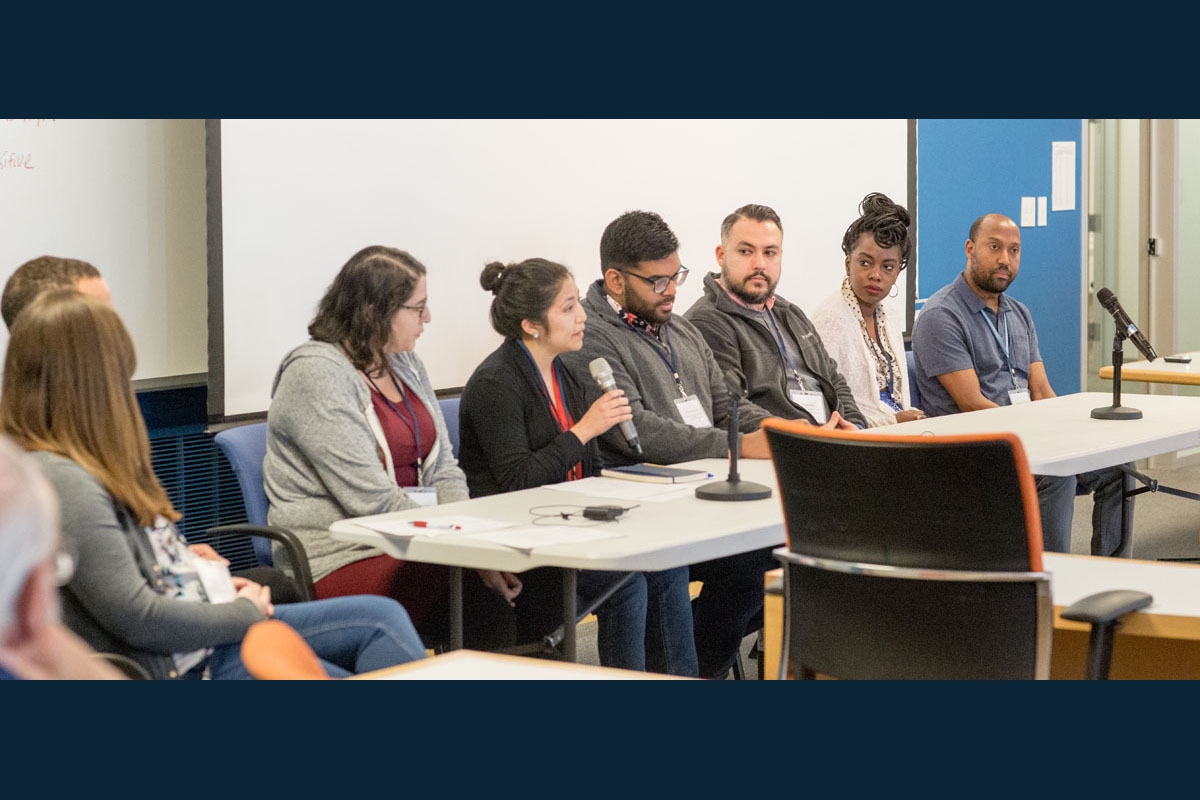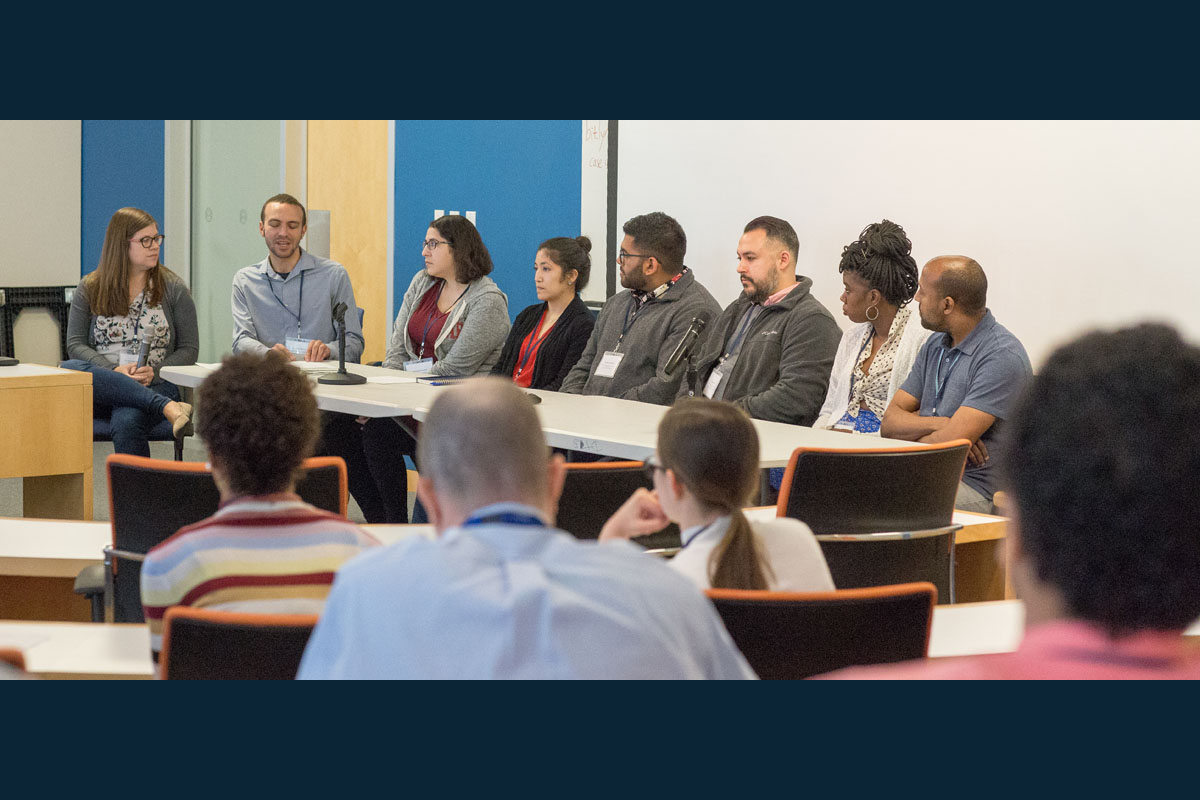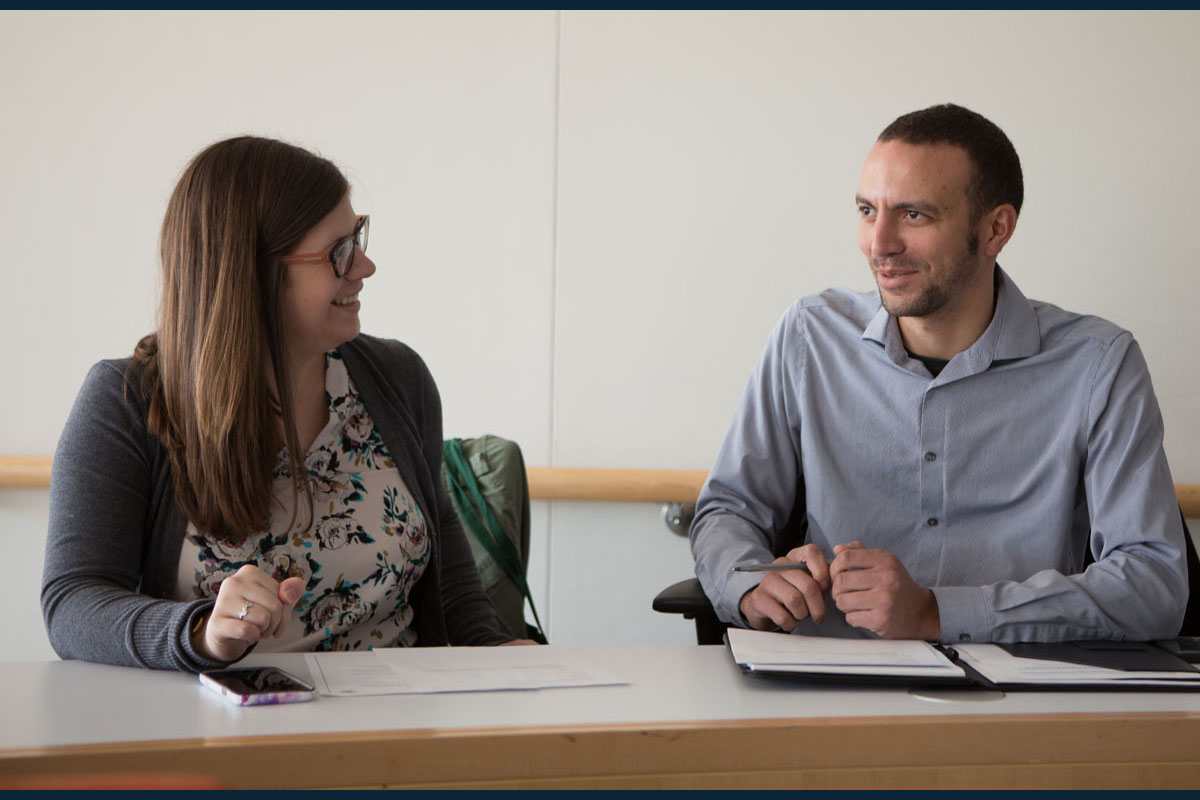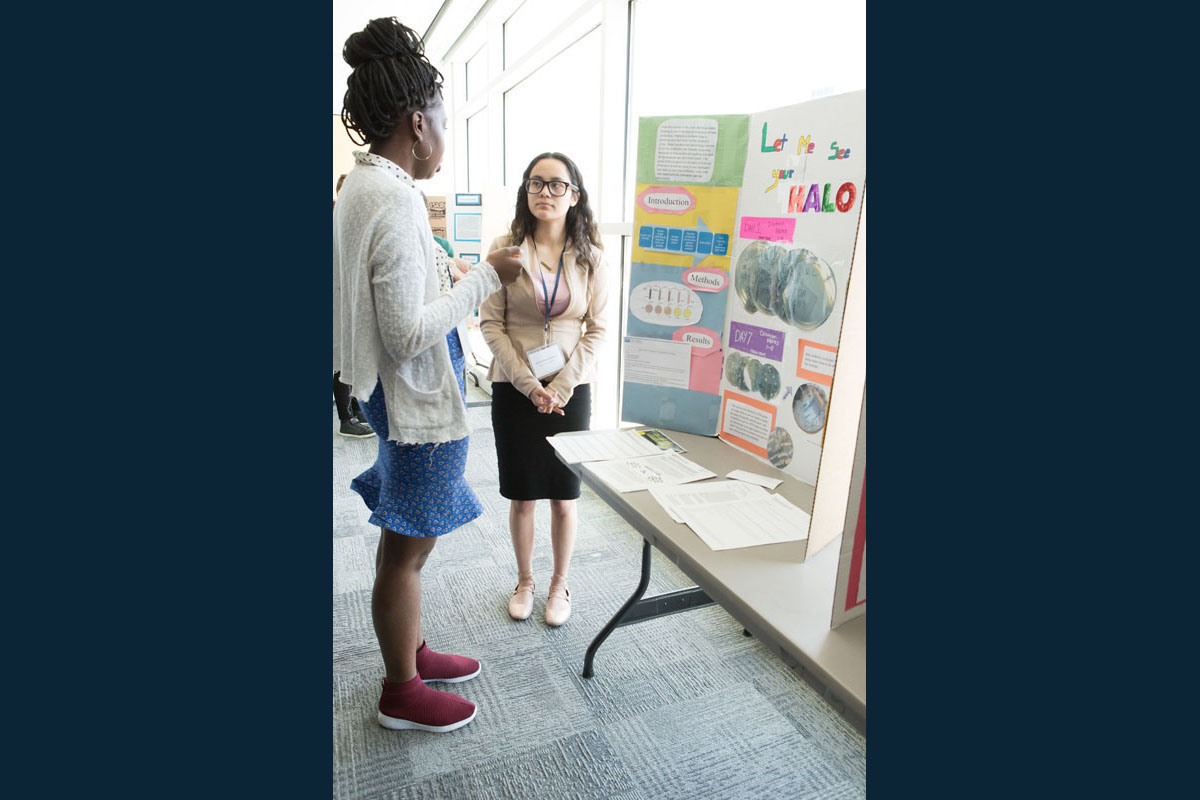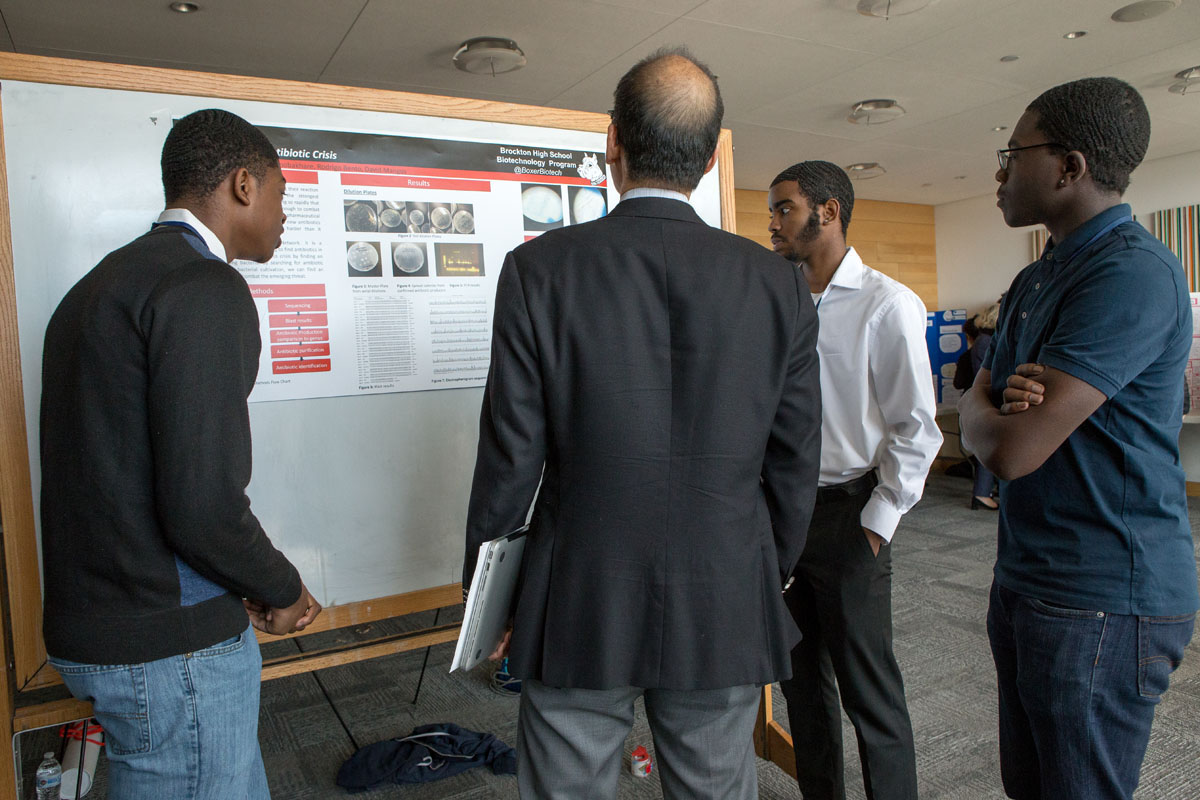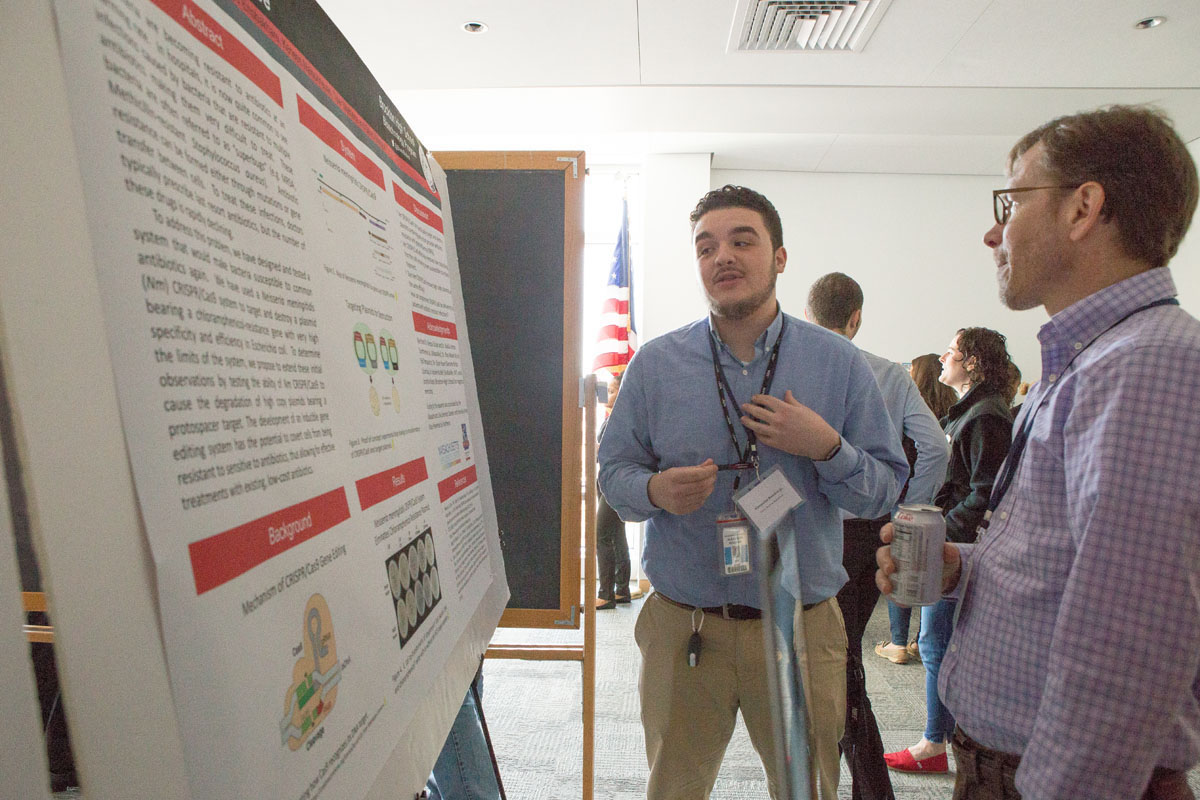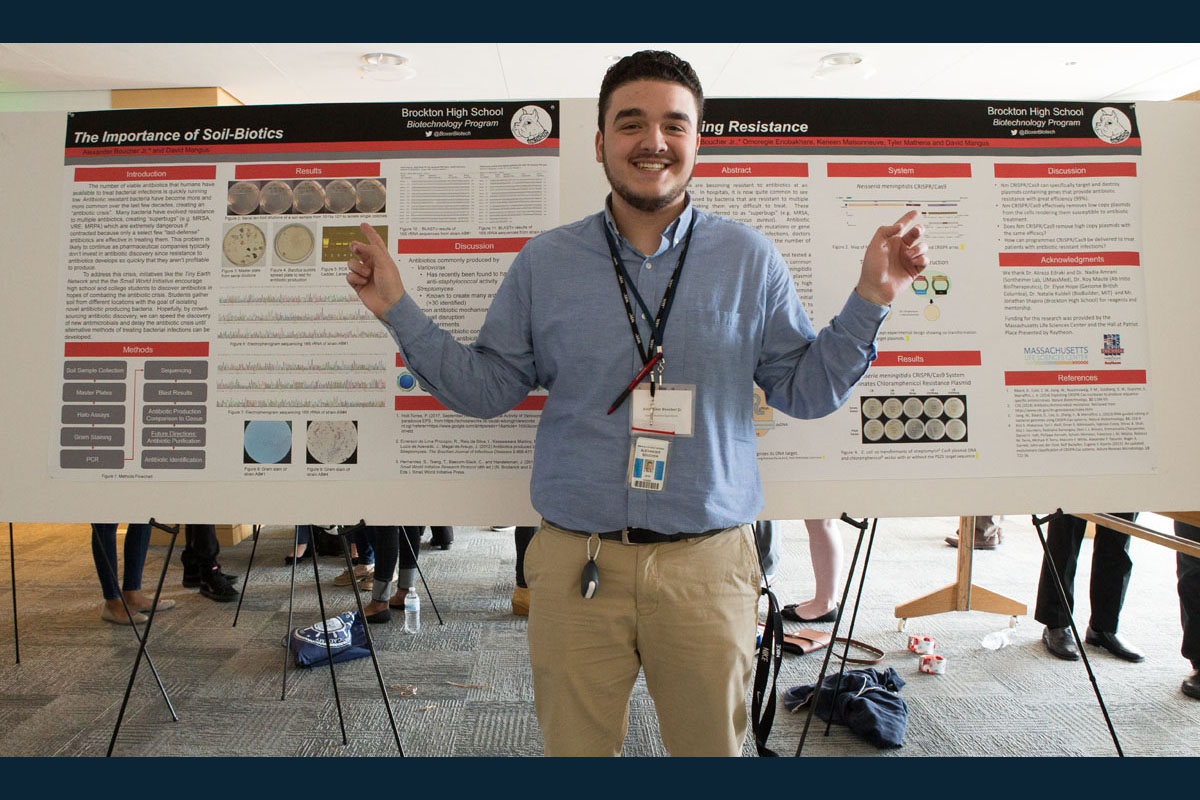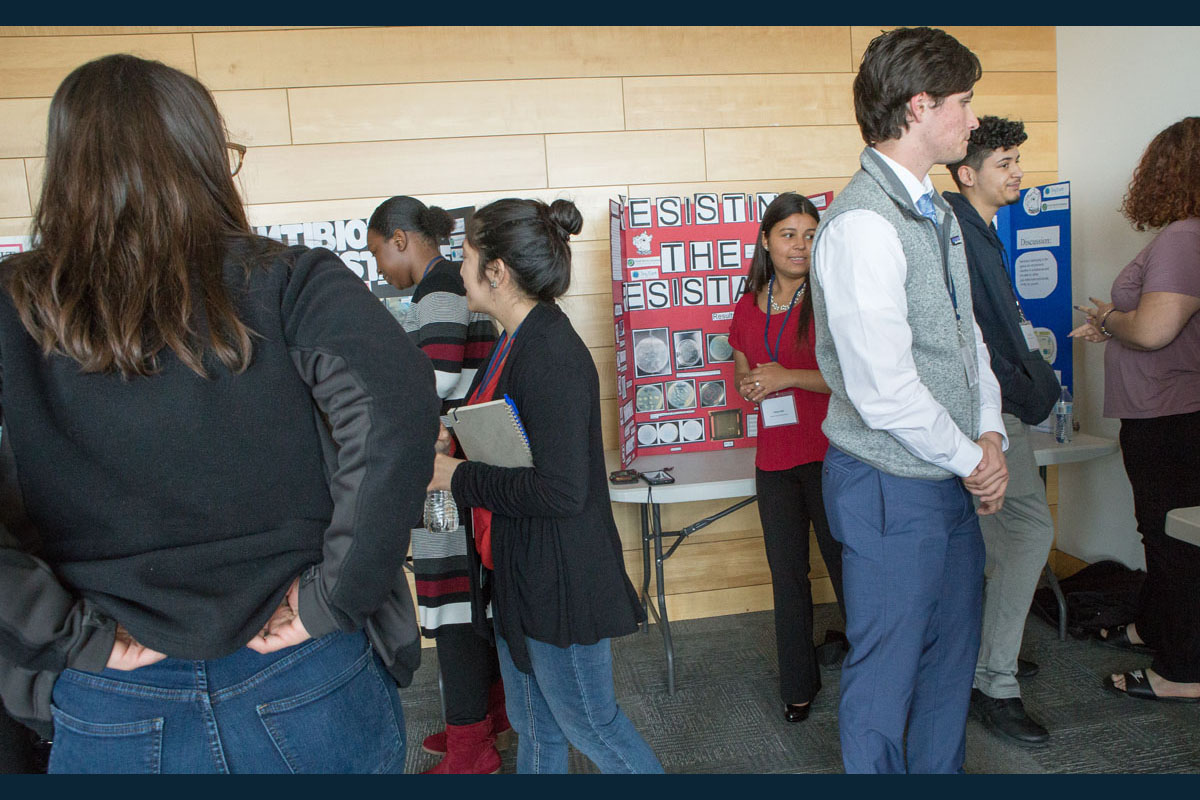CIMAR Outreach Day Provides High Schoolers Rare Educational and Networking Opportunities

May 2023 Update: After a hiatus due to the COVID-19 pandemic, we welcomed Brockton High School Students back to Tufts in May 2023. Learn more here: “Superbugs From Their Backyards and Beyond: Brockton High Schoolers Present ‘Tiny Earth’ Findings to Levy CIMAR; Tufts Community.” Or to learn more about the Levy CIMAR and Brockton’s Biotechnology Program, continue reading below:
May 23, 2019
Rima Mycynek

Brockton High School Biotechnology students observe a scientific talk from CIMAR’s Dr. Shira Doron. (Photo Credit: Claudette Gardel, Ph.D.)
The Tufts Center for Integrated Management of Antimicrobial Resistance hosted 33 students from Boston-area Brockton High School last week for a science outreach event. The students presented posters depicting original experiments and data on antimicrobial resistance to a wide audience of Tufts University and Tufts Medical Center graduate students, postdoctoral fellows, faculty, and clinicians.
The event posed a rare educational and networking opportunity to Brockton High sophomores and seniors interested in science. Their mentor, Biotechnology Lead Teacher Dr. Dave Mangus, runs a unique educational program at the school that includes getting students out of the classroom and presenting their findings to scientific professionals on their own turf.
The four-year program also allows students to explore fundamental concepts in biology via an engineering perspective (e.g., genetic engineering, synthetic biology, and biomimicry). Students spend the first two years of this program learning these concepts, and in their third year, they explore chemistry using a forensics theme. They then finish the program with an original capstone research project in their senior year. Now in its seventh year, the program has grown dramatically and currently serves about 350 freshmen through seniors.
According to Dr. Mangus, who prior to coming to Brockton served as a research assistant professor at the University of Massachusetts Medical School in Worcester, approximately a third of his students are enrolled in the college-prep advanced (CPA) level of this program and for them, this is an alternative pathway to traditional, textbook-focused classes by which they can meet their science requirements for graduation. The remaining students are enrolled at the honors level with most hoping to pursue STEM careers.
CIMAR Core Faculty member Dr. Carol Bascom-Slack from the Tufts University Center for Translational Science Education and head of the Prevalence of Antibiotic-Resistance in the Environment (PARE) project for high schoolers led the event.
“We are fortunate here in that we have a veterinary school, a medical school, a hospital, an engineering school, and more—all different types of disciplines with experts who can attack the problem of antimicrobial resistance from multiple angles,” Dr. Bascom-Slack told the group. “We need students like you who will one day help discover the next antibiotics.”
CIMAR’s Dr. Shira Doron, an attending physician at Tufts Medical Center, discussed antimicrobial resistance in healthcare and presented the students with a case study similar to what they might see if they one day enroll in medical school. This case study described an elderly cancer patient who was hospitalized and received several rounds of antibiotics for what doctors thought were bacterial infections. Although the patient overcame the cancer, she later developed a urinary tract infection that spread to her blood. The infection was caused by Klebsiella pneumoniae, which is known to easily harbor resistance. In the case of this patient, the pathogen was resistant nearly every antibiotic available, and so she was treated with what doctors call last-resort antibiotics. The patient continued to develop resistant infections until her death several months later.
Dr. Doron is Physician Director of Tufts Medical Center’s Antimicrobial Stewardship program, which launched in 2003 to advocate for the appropriate use of antibiotics. She explained to the students that we can all play a part in fighting antimicrobial resistance, for example by avoiding asking our doctors to prescribe antibiotics for sinus infections and the like until we’ve given them a chance to pass on their own—according to the CDC, about 30 percent of antibiotics are prescribed to patients unnecessarily. Dr. Doron told the students, “You might ask what you as students can do to combat antimicrobial resistance. You might think nothing, but it’s actually a lot.”
Dr. Joyce Sackey, Dean of Multicultural Affairs and Global Health at Tufts University’s School of Medicine, turned the conversation to the importance of programs like the one Dr. Mangus runs at Brockton High School and PARE, which allow students to explore real-world problems and work with the same tools that scientists use every day.
“I was inspired to pursue science by my chemistry teacher, but it wasn’t enough to be inspired in chemistry–I needed to see the direct application in science,” she said. “We believe that there are so many talented young people out there, and we can’t leave it to chance that they might be inspired to stick with science long enough to see how important it can be as we apply it to the vexing medical problems we see every day.”
Dr. Sackey runs the Tufts Teachers and High School Studentsprogram, which provides a bridge between high school students and the medical community. Students accepted into the program are assigned mentors and provided with research and clinical experiences that may span Tufts Medical Center and Tufts University’s School of Medicine, Department of Public Health and Community Medicine, Freidman School of Nutrition, Graduate School of Biomedical Sciences, and School of Dental Medicine.
Overcoming Obstacles: A Panel Discussion

CIMAR panelists (L-R) Katherine Suarez, Vanessa Yanez, Ramesh Govindan, Jesus Romo, Faye Vassel, and Tracy Washington (Photo Credit: Claudette Gardel, Ph.D.)
One of CIMAR’s goals in organizing this Outreach Day was to show the students attending that science thrives on teamwork and diversity. Drs. Walter Adams and Elizabeth Draganova, both postdoctoral fellows in the Department of Molecular Biology and Microbiology at Tufts University School of Medicine, pulled together a panel of students and postdocs for a question-and-answer discussion with the high schoolers. These scientists shared their experiences and answered questions about their own challenges and rewards in entering science.
Dr. Jesus Romo, a postdoctoral fellow in the same department, came to the United States from Mexico when he was 10 years old. When asked what his biggest challenge or obstacle to success has been, he described “imposter syndrome,” or the persistent inability to believe that one’s success is deserved or has been legitimately achieved as a result of one’s own efforts or skills.
“I still struggle with this today, but it’s normal—and if you encounter it at any stage in your career, remember that it is normal,” said Dr. Romo. “This can happen to anyone whether you’re a minority or not, but minority populations tend to deal with a stronger version of it. But, the one thing that’s important to remember is that you put in the work. You worked very hard to get to where you are, and you deserve to be there.”
Dr. Tracy Washington, also a postdoctoral fellow in the Department of Molecular Biology and Microbiology, added that the lack of self-confidence that comes with imposter syndrome can be dangerous to academic success.
“In high school and college, I felt like I was very much in control of my success,” said Dr. Washington. “When it came to graduate school, everything felt different, and for the first time I started to feel like I wasn’t good enough to meet those obstacles.”
“I would call my mom and ask her what to do, and she would tell me to find my confidence—but that’s easier said than done,” he added. “I discovered that it was important to have a good support network. So, I reached out to friends, I talked to my advisor, I went to therapy, and found it very helpful.”
The panel fielded additional questions about their experiences in high school, what brought them to science fields, and whether it was difficult to commit to the years of schooling required to earn their graduate and/or medical degrees.
Poster Session: Studying the Causes of Antimicrobial Resistance and Figuring Out How to Fight It

Brockton High Senior, Alexander B., describes his project on CRISPR-Cas9 to CIMAR Core Faculty Member, Dr. Andrew Camilli (Photo Credit: Claudette Gardel, Ph.D.)
The Brockton High biotechnology program students prepared 25 scientific posters for the CIMAR outreach event, each of which showcased their original research on antimicrobial resistance.
Seniors in the program analyze soil samples from their community to identify strains of bacteria that produce novel antibiotics as part of the Small World InitiativeandTiny Earth Network, programs similar to PARE where data is crowdsourced from students and their instructors around the globe. “In this class, I try to give students a taste of what it is like to work in a research setting,” said Dr. Mangus. “In as much, I ask that they present their results to the scientific community. Last year, they did that by visiting Tetraphase Pharmaceuticals in Watertown [Massachusetts].”
“We have very well-equipped microbiology and molecular biology labs to help facilitate their research,” he added. Those labs include micropipettes, agarose and SDS PAGE electrophoresis units, UV and blue light boxes, PCR machines, qPCR machines, visible/UV/fluorescence spectrophotometers, autoclaves, mediaclave, and much more that the school acquired though a grant from the Massachusetts Life Sciences Center.
Students like Miladi T. were eager to discuss their research and findings. “For my project our objective was to isolate bacteria in order to find antibiotic producers,” said the Brockton High senior. “These bacteria are the good guys that we hope can help us find new drugs that will kill the [illness-causing] bacteria that are resistant.”
“I got my soil samples from my backyard and in that soil, we found antibiotic producers of the Burkholderiagenus,” she continued. “Later on, I read that Burkholderia species are known to produce antibiotics that can fight against different bugs. It was really satisfying to me that we did the work first and then read something that showed us we were on the right track.”
Fellow senior Alexander B. presented on “Rewriting Resistance,” which refers to the genome-editing method, CRISPR-Cas9. This method allows scientists to access and destroy resistance genes in bacterial cells, making those cells vulnerable to antibiotic treatments.
“In theory, our future steps would be to develop an injection that we can give patients before we give them antibiotics,” said Alexander. “In the injection, we would have bacteriophages [viruses that can kill bacteria] with the CRISPR-Cas9 system inside. The idea is that those bacteriophages would invade the bacteria, remove the resistance genes, and allow the patient to be cured easily with antibiotics like penicillin.”
The sophomores who joined their peers for this event are part of Brockton High’s STEM Biotech II Honors classes. They are participating in an educational outreach project in collaboration with Dr. Amir Mitchell’s laboratory at UMass Medical School called “Emergence of a Superbug.” In this research project, students submit variables to program a robot at UMass to alter bacterial growth conditions, including what types of antibiotics are introduced and in what amounts, to learn more about how antibiotic resistance forms.
The students presented their posters to over 40 members of the Tufts University and Tufts Medical Center community. To see these and other posters as well as other photos from the day, please refer to the slideshow below.
Written by Rima Mycynek, Project Administrator for CIMAR
Edited by Dr. Bree Aldridge and Rima Mycynek






